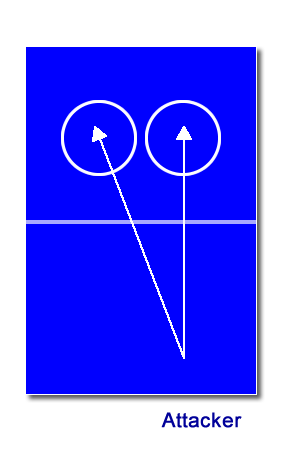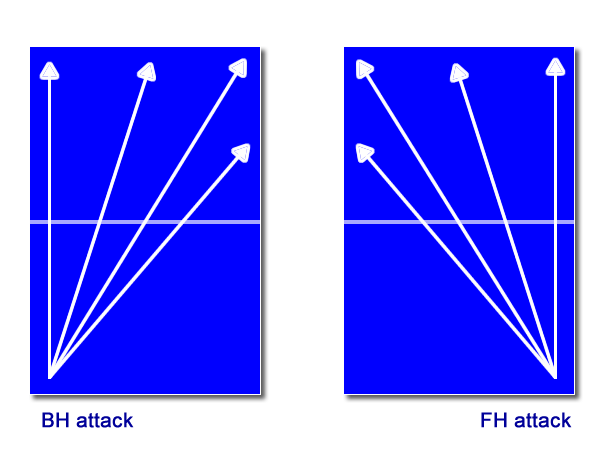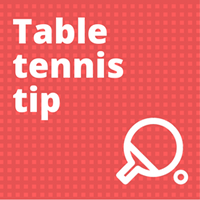One of the (many) ways you can get better at table tennis is to improve the placement of your attacks.
This is often what separates ‘very good’ table tennis players from merely ‘good’ table tennis players.
As a player and a coach, I have been aware of this for some time. But it really hits home whenever I play against a very good French player, Ronald, at my Cambridge-Parkside Table Tennis club.
Ronald is a master of well placed attacks. He isn’t the fastest attacker I have ever played or even the spinniest (although he does generate a lot of topspin!), but his attacks are just so well placed.
He is able to consistently get the ball within a few centimeters of the end / side lines of the table. Left corner, right corner, middle, off the side – he can hit them all.
I haven’t ever got close to beating Ronald. But you know what? I don’t really mind, as it’s a pleasure being beaten by a player whose attacks are so accurate!
So what can we learn from Ronald? Here’s three simple things to consider if you want to improve the placement of your attacks…
1. Avoid the buckets

In this diagram, you can see I have drawn two circles in the middle of the table. I’m going to call these the ‘buckets’. In almost all situations, you should avoid attacking to these areas.
Why?
Attacks to the buckets are the easiest for your opponent to return. Your opponent doesn’t have to move much – whether left, right or back. He/she can stay close to the table and block or counterattack fairly easily.
When I play, I love it if my opponent attacks the buckets. Not only are the attacks easy to return, but because the attack is shorter I can play quick, aggressive blocks, which put my opponent on the back-foot. I gain an advantage because my opponent’s attack is short and didn’t put me under any pressure.
2. Aim for the lines

So if attacks to the buckets are no good, what should you do instead? To put your opponent under more pressure, you should try and get your attacks deeper or wider.
Put simply, aim for the lines.
As this diagram shows, this could mean aiming for the corners, the middle or side of the table.
Why is this better?
When you aim for the lines, you force your opponent to move more – left, right or back. This has two main benefits:
- It’s harder for your opponent to play a good quality block or counter attack, if he/she is moving at the same time.
- By making your opponent move, you can open up the table. Even if he/she does return the ball, you will have created some good angles for your next attack.
The other real benefit of getting your attacks ball deep is that it takes time away from your opponent (if he/she doesn’t back up). If you opponent stays up close to the table and your attack is very deep, your opponent will have hardly any space to to play a stroke to return the ball.
This is very true at a local league level, especially in the lower divisions, where players don’t really back-up much. If you attack near the end line, you’ll often win the point without your opponent getting close to returning the ball.
3. Vary the position of your attacks
To be an even better attacker, you should try and vary the position of your attacks. This is something I drill into the players I coach all the time.
Some players make the mistake of attacking the same position all the time. This soon becomes predictable. Even if you get your attacks deep, they will be less effective if always played to the same position.
But if you can vary the position of your attacks and get them close to the line, you’ll cause havoc. It’s much harder to defend against a player who can attack any position on the table.
Even if you can’t do it now, your long term aim should be to be able to attack the different positions shown below.

Placement vs power
Up to a certain level, placement is far more important than power (professional players need both placement and power). So if you play at an amateur level – local leagues or tournaments – you’ll have far more success by learning to place your shots consistently close to the lines, rather than trying to blast the ball as hard as you can.
And there’s only one way to get good at improving your placement – that magic ‘P’ word again – PRACTISE. At first you may find you make more errors by hitting the ball long or wide. But this is ok. The more your practise, the more accurate you will become.
I’d rather hit one ball long and get the next four close to the line, than getting all five safely in the middle of the table. In the first scenario I have good chance of winning 4-1. In the second scenario the score may go my way, or I my attacks may be easily returned and I lose all 5 points.
So in summary, one way to improve your attacking game is to focus on the placement of your attacks.
You should:
- Avoid the buckets
- Aim for the lines
- Vary the position of your attacks
Now go practise and destroy your opponents!
Take your game to the next level
If you are serious about improving your table tennis skills, I recommend you join Tom’s TT Academy. In my online academy, you will get access to a wide range of coaching content, including:
- in-depth courses
- training drills
- video analysis
- fitness videos
- robot training videos
- member discussions
- skill challenges
- and lot’s more!
You can access all this content for less than £1 per week. New content is added regularly. Join hundreds of table tennis players around the world today at tomsttacademy.com

